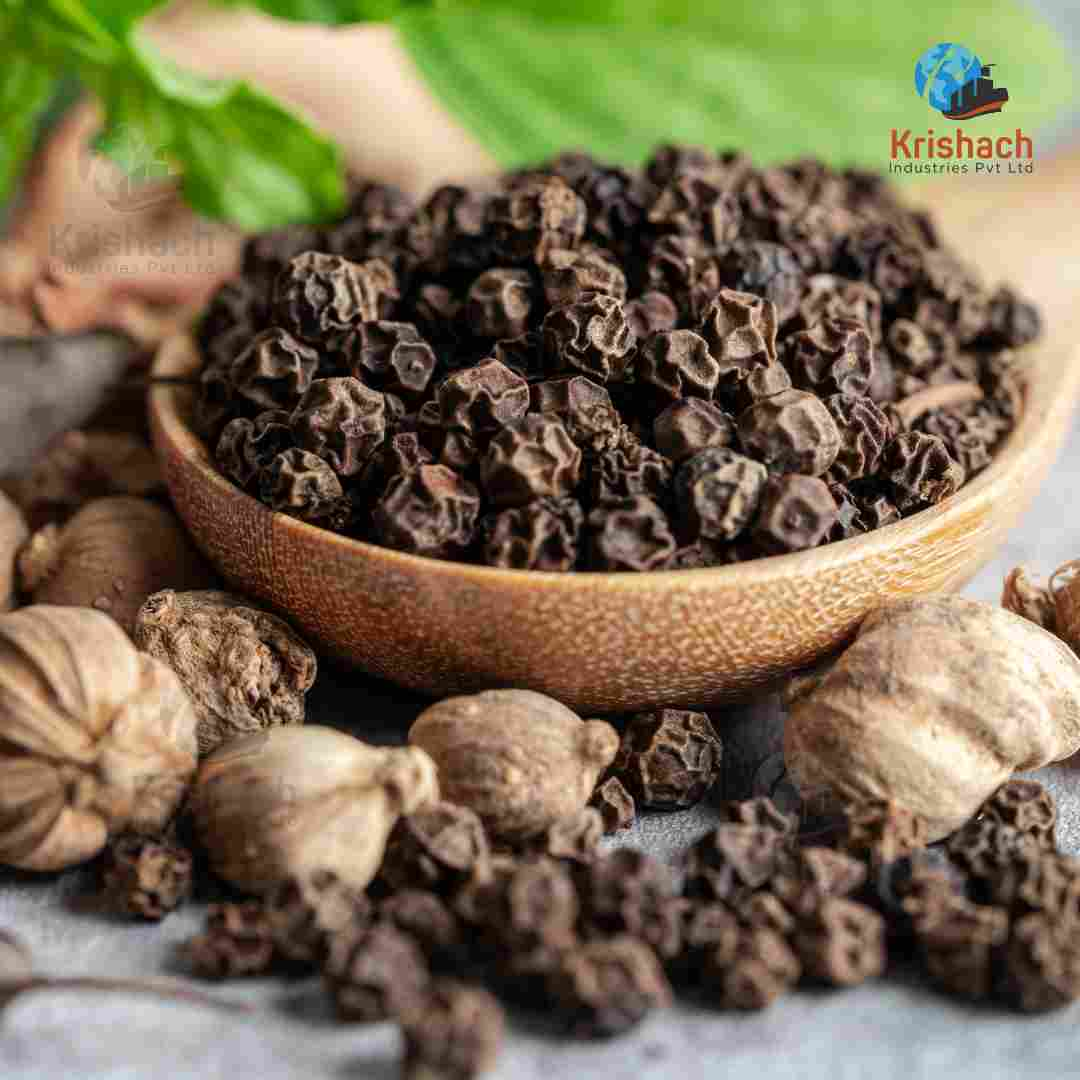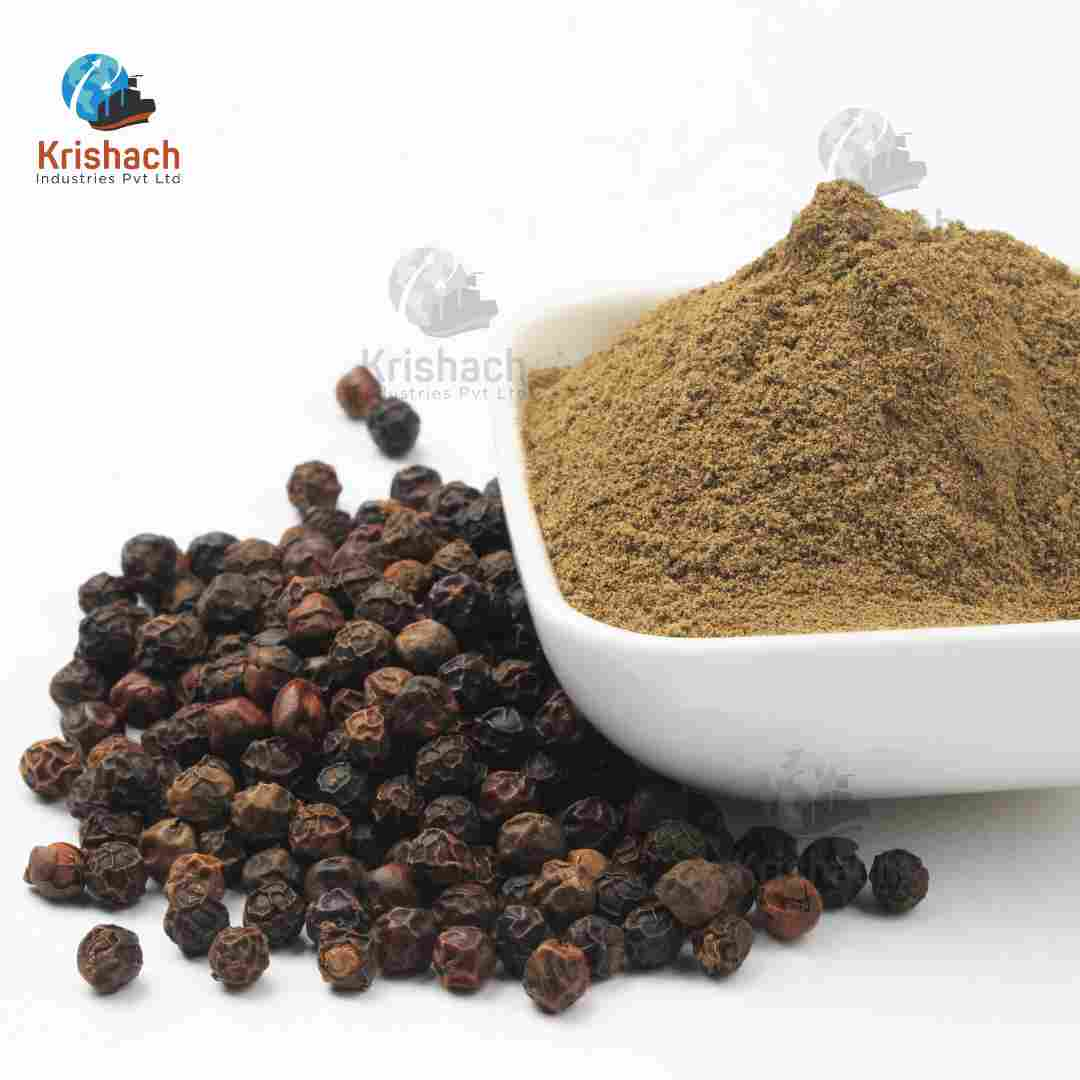Black pepper, often referred to as the “king of spices,” is the dried fruit of the Piper nigrum plant, a flowering vine native to the tropical regions of South India and Southeast Asia. The peppercorns are small, round, and typically 3-4 mm in diameter, with a wrinkled, dark brown to black outer surface. Black peppercorns are harvested while still green and unripe, then briefly cooked in hot water to clean and prepare them for drying. As they dry, the outer skin shrinks and darkens, forming their characteristic black appearance.
Key Characteristics of Black Pepper:
Shape: Small, round, with a wrinkled surface.
Size: Typically 3-4 mm in diameter.
Color: Dark brown to black, depending on the drying process and variety.
Aroma and Flavor: Pungent, sharp aroma with a warm, woody, and slightly spicy flavor; contains piperine, which provides its heat and pungency.
Composition: High in essential oils and piperine, which contribute to its aromatic and medicinal properties.
Specification:
Uses:
Black pepper is widely used as a spice in various cuisines around the world for its strong, pungent flavor and aroma, enhancing the taste of both savory and sweet dishes. Additionally, it is valued for its digestive and antioxidant properties, making it a staple in culinary and medicinal practices.
Benefits:
Black pepper is rich in antioxidants and may have anti-inflammatory, antimicrobial, and digestive properties. It may also enhance nutrient absorption and aid weight management.
Cultivate Seasons for India:
Black pepper is typically cultivated during the monsoon season in India, with sowing usually done in June-July and harvesting in December-January.
Our Services
Reliable Sourcing:
Reliable sourcing of black pepper starts with selecting high-quality peppercorns from trusted regions known for their superior production, such as India (especially Kerala), Vietnam, Brazil, and Indonesia. These regions provide ideal growing conditions—warm, tropical climates and rich, well-drained soils—that enhance the flavor, aroma, and piperine content of the peppercorns. It is crucial to partner with suppliers who adhere to Good Agricultural Practices (GAP) and sustainable farming methods, ensuring that the pepper is cultivated without synthetic pesticides and is free from contaminants. Reliable sourcing also involves traceability, allowing buyers to verify the origin, production methods, and handling of the peppercorns throughout the supply chain, ensuring a consistent supply of high-quality black pepper.
Premium Quality Assurance:
Premium quality assurance for black pepper involves multiple checks and stringent controls throughout the production process. This begins with selecting peppercorns that are harvested at the right time, ensuring optimal maturity, size, and flavor profile. The peppercorns undergo rigorous cleaning, drying, and sorting processes to remove impurities, mold, or damaged grains. They are then graded based on size, color, and density, with higher grades reflecting a superior aroma, flavor, and piperine content. Quality testing for moisture levels, essential oil content, and microbial contamination is conducted to meet international standards, such as ISO, HACCP, and ASTA. Finally, the pepper is packaged in airtight, food-grade materials to preserve its freshness, flavor, and potency during storage and transport, ensuring it reaches the market as a premium product with consistent quality.
Black Pepper Processing:
The processing of black pepper begins with the careful harvesting of pepper berries from the Piper nigrum vine when they are fully mature but still green. The harvested berries are cleaned thoroughly to remove dirt, debris, and any impurities. Next, the berries are briefly blanched in hot water to clean them further and to prepare the outer skin for drying. The berries are then sun-dried or mechanically dried for several days until the outer skin shrinks and turns black, a process that helps develop the peppercorns’ distinctive flavor, aroma, and pungency. After drying, the peppercorns are sorted and graded based on size, color, and density, with larger, darker, and heavier peppercorns typically considered higher quality. Quality control measures are implemented to check for moisture content, essential oil levels, and the presence of contaminants like mold or bacteria. Once they pass quality tests, the peppercorns are packaged in airtight, food-grade containers to preserve freshness and protect against moisture and pests. The final product is stored in cool, dry conditions before being distributed to markets worldwide, ensuring a high-quality spice with robust flavor and aroma.
Packaging, Shipping & Delivery
Packaging:
Bags and Pouches:
For Black Pepper, high-quality food-grade materials such as laminated multi-layer pouches (made of materials like PET, PE, BOPP, and Aluminum foil) are used. These bags are moisture-proof and help retain the freshness, flavor, and aroma of the spices. Zip-lock pouches, stand-up pouches, and resealable bags are also popular for smaller quantities.
Polypropylene (PP) Woven Bags:
These are the most common types of bags used for packaging large quantities (25 kg and 40 kg) of Black Pepper. They are made of woven polypropylene material, which is strong, lightweight, and durable, providing excellent resistance to tearing and damage during handling and transport.
Laminated Bags:
For additional protection against moisture and humidity, PP woven bags can be laminated with a layer of plastic film. This lamination creates a barrier against moisture, ensuring the spices stay dry and fresh during transportation and storage.
Multi-Wall Paper Bags:
These bags consist of several layers of kraft paper, which provide strength and are often lined with a plastic or polyethylene layer to offer protection against moisture and humidity. They are environmentally friendly and widely used in many markets for exporting food products.
Vacuum-Sealed Packaging:
This type of packaging removes air from the package before sealing, which helps prevent oxidation and moisture build-up, preserving the quality and extending the shelf life of the spices.
Paper or Carton Boxes:
After the packaging, the smaller bags or pouches are placed in corrugated cardboard cartons or paper boxes. These cartons are sturdy, stackable, and protect the contents from physical damage during handling and transportation.
Palletization and Wrapping:
Cartons or sacks are often stacked on wooden or plastic pallets and wrapped with stretch film or shrink wrap. This provides stability, reduces the risk of damage during transport, and makes handling more efficient.
Export Documentation:
Handle all necessary export documentation, including phytosanitary certificates, certificates of origin, and any specific certifications required by the importing country.
Efficient Shipping:
Partner with reliable freight forwarders and logistics companies to ensure timely and safe delivery of goods. Offer multiple shipping options (air, sea, or land) based on customer preferences.
























